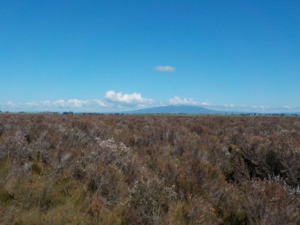Houdinia facts for kids
Quick facts for kids Houdinia |
|
|---|---|
| Scientific classification | |
| Kingdom: | |
| Phylum: | |
| Class: | |
| Order: | |
| Family: |
Batrachedridae
|
| Genus: |
Houdinia
Hoare, Dugdale & Watts, 2006
|
| Species: |
H. flexilissima
|
| Binomial name | |
| Houdinia flexilissima Hoare, Dugdale & Watts, 2006
|
|
The Houdinia is a special type of moth. It is the only species in its group, called a monotypic genus. This moth, known scientifically as Houdinia flexilissima, lives only in the raised bogs of northern New Zealand.
It is considered "At Risk, Relict" by the Department of Conservation. This means it is a rare species that needs protection. The caterpillars of this moth are sometimes called Fred the thread because they are very long and thin.
Contents
About the Houdinia Moth
Naming the Moth
This unique moth was first described in 2006. Three scientists, Robert Hoare, John Dugdale, and Corinne Watts, studied a specimen found in the Torehape wetland in Waikato. The main specimen they used for the description is kept in the New Zealand Arthropod Collection.
Scientists think two other types of moths, found earlier but not yet fully described, might be related to the Houdinia moth. One lives in Machaerina teretifolia plants in New Zealand. The other lives in Lomandra longifolia plants in Australia.
Why the Name "Houdinia"?
The scientists chose the name "Houdinia" for fun! It refers to the famous escape artist Harry Houdini. They picked this name for two reasons:
- First, the adult moth has to 'escape' from the tiny space where it grows.
- Second, the moth itself seemed to 'escape' being noticed by insect experts until Corinne Watts found it in 2003.
The second part of its scientific name, "flexilissima", comes from Latin. It means 'very flexible'. This name was chosen because of how flexible the caterpillars are.
Fred the Thread
Before it got its scientific name, Corinne Watts and Robert Hoare started calling the caterpillar of this moth Fred the thread. This fun name has become quite popular!
What the Houdinia Moth Looks Like
The caterpillars of the Houdinia moth are very long and thin. They are orange and can grow to about 2 centimeters (almost an inch) long. But they are only about 1 millimeter wide!
The adult moth is much smaller. It is about 0.5 centimeters long and has a wingspan of 1.2 centimeters. It has a silver-grey color.
Where the Houdinia Moth Lives
Corinne Watts first found this moth in 2003 at a small bog called Torehape. As of 2006, it was only known from three special wet areas called peatlands. These areas are all in the Waikato region, in the northern part of New Zealand's North Island. This means the moth is endemic to this small area.
The plant the moth lives on has been moved to three other places in Waikato to help it grow. The moth seems to have moved with its host plant to these new areas. This is good news for its survival!
Houdinia Moth's Habitat and Life Cycle
Habitat
The caterpillars of the Houdinia moth live on a specific plant. This plant only grows in special places called raised peat bogs. These bogs used to cover much more land. However, many have been drained for farming or dug up for fuel. This has reduced the places where the moth can live.
Life Cycle
Adult Houdinia moths fly around from late Spring to mid-Summer. In New Zealand, this is usually from late October to mid-December. It seems that the Houdinia flexilissima moth has a two-year life cycle. This means that while some moths are flying, younger caterpillars are still growing inside their plants.
Food Plant
This moth is very picky about its food! The caterpillars only eat one type of plant. They tunnel and grow inside the living stems of Sporadanthus ferrugineus. This is a large, rush-like marsh plant that is found only in New Zealand.
Protecting the Houdinia Moth
The Houdinia flexilissima moth is very special and needs our help. It is unique, and the plant it lives on is also rare. Because of this, it is considered a species that needs high conservation.
In 2017, this moth was listed as "At Risk, Relict" under the New Zealand Threat Classification System. This means it is a species that is not doing well and needs protection.
The moth has been found in these protected areas:
- Moanatuatua Scientific Reserve, Waikato region, New Zealand


